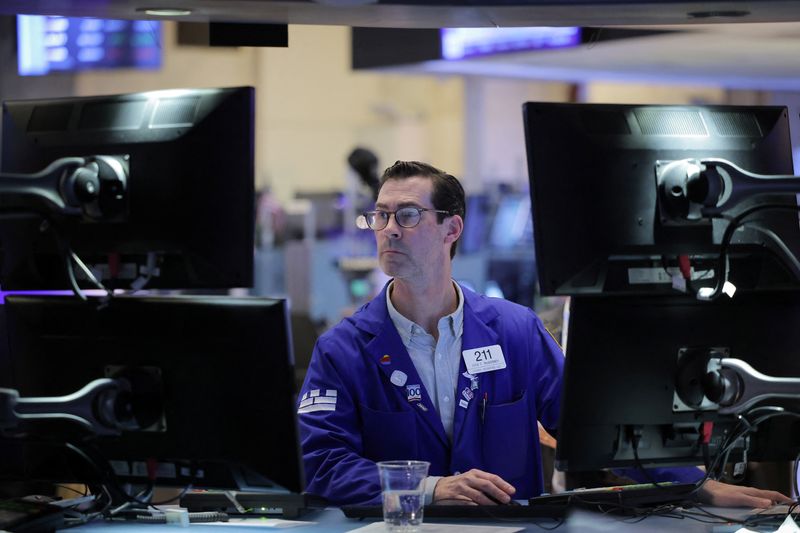Investing.com – US stock futures hovered around both sides of the flatline on Thursday, with inflation data and commentary from Federal Reserve speakers in focus. Republicans gain a majority in the US House of Representatives, giving the Donald Trump’s party a grip over both chambers of Congress. Elsewhere, Cisco Systems (NASDAQ:CSCO) shares slip as its full-year financial forecast falls just short of analysts’ expectations.
1. Futures muted
US stock futures pointed to a muted open on Thursday as investors digested monthly inflation data and looked ahead to comments from Federal Reserve Chair Jerome Powell.
By 03:30 ET (08:30 GMT), the Dow futures contract had inched up by 30 points or 0.1%, S&P 500 futures were mostly unchanged, and Nasdaq 100 futures had fallen by 14 points or 0.1%.
On Wednesday, the benchmark S&P 500 and 30-stock Dow Jones Industrial Average both ticked higher, while the tech-heavy Nasdaq Composite retreated. Labor Department figures showed that consumer prices grew in line with estimates in October, adding to bets that the Fed would slash interest rates at its upcoming meeting next month.
The rate-sensitive 2-year US Treasury yield dipped following the report, while its longer-term 10-year and 30-year counterparts inched up. Analysts at Vital Knowledge noted that concerns remain around the potential inflationary impact of the incoming Trump administration’s policy plans.
2. Republicans win control of House
Republicans have secured a majority in the US House of Representatives, giving President-elect Donald Trump’s party control over both chambers of the legislature.
The victory, which comes more than a week after Trump notched an overwhelming win in the presidential election, possibly eases the path ahead for him to enact his agenda laid out during the campaign — including fresh tax cuts, looser regulations on businesses, and blanket tariffs on imports coming into the US.
Meanwhile, the opposition Democrats will be in the minority in both the House and Senate when the new legislative session begins in January, although Democratic House leader Hakeem Jeffries said the Republicans will have only a “razor-thin majority.”
Despite the losses, Democrats could still exercise some influence over the Trump administration’s major policy objectives in limited but meaningful ways. Crucially, in the 100-person Senate, many pieces of legislation would need to surpass a 60-vote threshold to break a key filibuster rule and become law.
While Republicans could move to ditch the filibuster, John Thune, the Republican elected as the new Senate majority leader on Wednesday, has said it would remain “unchanged” while he is in the role.
3. Cisco outlines muted annual guidance despite quarterly earnings beat
Shares in Cisco Systems ticked slightly lower in extended hours trading on Thursday after the networking equipment manufacturer unveiled a tepid full-year outlook.
The group, which is viewed as a gauge for corporate spending on technology, said it now expects annual revenue to be between $55.3 billion and $56.3 billion. Although this was up from a prior forecast of $55.0 billion to $56.2 billion, the midpoint of the guidance range was below the $55.9 billion projected by Wall Street.
Cisco’s fiscal second-quarter sales are also seen at $13.75 billion to $13.95 billion, versus the average analyst estimate of $13.74 billion.
Investors were eyeing the pace of Cisco’s ongoing push to boost orders, which are recovering from a year-long dip fueled by many customers choosing to delay purchases as they offload built-up inventories.
Revenue for the quarter ended on Oct. 26 dropped by 6% to $13.84 billion, topping expectations, while adjusted profit per share also beat estimates. Prior to the earnings, the stock had climbed by more than 17% so far this year.
Elsewhere on Thursday, traders will be keeping tabs on results from chip gear provider Applied Materials (NASDAQ:AMAT) and media giant Walt Disney (NYSE:DIS).
4. Powell to speak
Markets will also likely be following comments on the outlook for the economy from Fed Chair Jerome Powell on Thursday.
Powell’s speech in Texas will come after the Fed cut borrowing costs by 25 basis points earlier this month. The central bank argued that while inflation was “somewhat elevated” the risks to achieving stable price growth and a resilient jobs market were “roughly in balance.”
How Powell sees inflation evolving in the coming months could be a major focus, particularly with some economists predicting that President-elect Trump’s policy proposals may place renewed upward pressure on prices — and persuade the Fed to leave rates at a higher level.
Media reports have also suggested that this uptick in volatility could exacerbate the possibility of a clash between the Fed and the Trump White House. Last week, Powell flatly rejected notions that Trump could dismiss him from his post, telling reporters that he would not resign if asked to by the upcoming administration.
5. Oil prices hit by demand fears
Oil prices fell Thursday, weighed down by concerns surrounding global demand growth as well as higher production.
By 03:31 ET, the Brent contract was broadly flat at $72.25 per barrel, while U.S. crude futures (WTI) traded 0.1% lower at $68.38 a barrel.
The Organization of the Petroleum Exporting Countries cut its forecast for world oil demand growth in both 2024 and 2025 earlier in the week, mainly on worries around top importer China’s demand, and the International Energy Agency is likely to follow suit when it publishes its monthly report later in the session.
Meanwhile, the US Energy Information Administration slightly raised its expectation of US oil output this year, while also increasing its global oil output forecast for 2024.
The EIA publishes its weekly crude oil and product stockpile data later in the session, a day later than usual following Monday’s Veterans’ Day holiday in the US.

